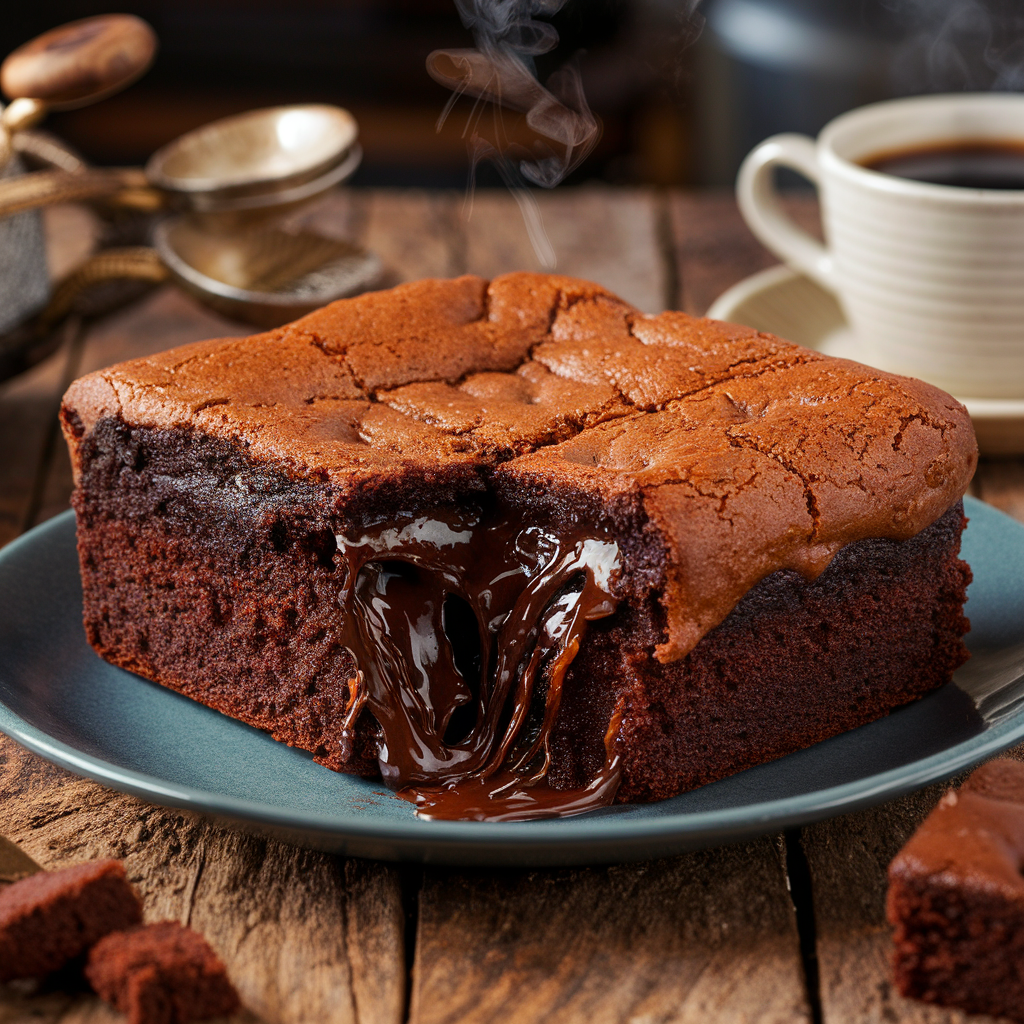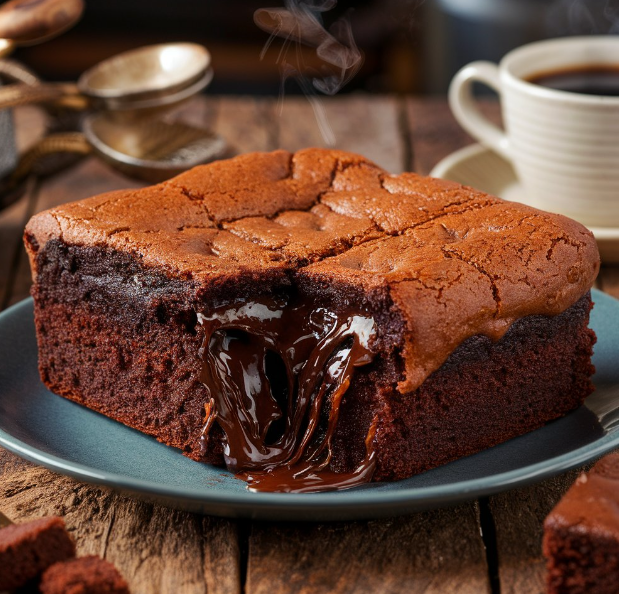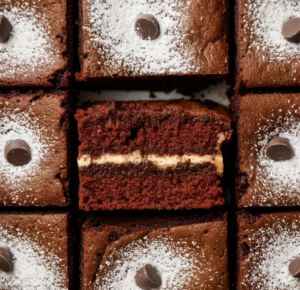Introduction to Brownie Cake
Brownie cake, a luscious blend of a traditional chocolate brownie and a cake, offers a denser, moister, and richer experience than its individual counterparts. It combines the best of both worlds, featuring the chewy texture of brownies and the structured crumb of cakes. In this section, we’ll delve into the historical roots of the brownie cake, discussing its evolution and how it has emerged as a favorite in bakeries and households alike.
History and Evolution
The concept of brownie cakes began with the simple desire to enhance the traditional brownie, adding more depth and variety to its texture and flavor profile. Initially, bakers experimented with different ingredients, aiming to find the perfect balance that would elevate the standard brownie into something more sophisticated and dessert-like. Over time, these experiments led to the creation of a hybrid that was not only perfect for special occasions but also versatile enough to be customized with various additives like nuts, fruits, and frosting.
Popularity in Modern Baking
Today, brownie cakes hold a coveted spot in the world of desserts. Their adaptability has made them a popular choice for celebrations and casual gatherings. The appeal lies in their rich chocolate flavor and the comforting, satisfying texture that can only come from a perfectly baked brownie cake. This treat has not only captivated the hearts of chocolate lovers but also inspired a myriad of recipes that cater to diverse tastes and dietary requirements, making it a universal delight.
In our next section, we’ll explore the key ingredients that are crucial to baking a delectable brownie cake, ensuring that every bite offers a burst of chocolaty goodness.
Stay tuned as we continue to unveil the secrets behind making the perfect brownie cake, ensuring your baking adventures are as delicious as they are rewarding.
Understanding the Core Components of Brownie Cake
When crafting a brownie cake, every ingredient plays a pivotal role in shaping the final outcome. Understanding these key components is essential for anyone looking to master the art of brownie cake baking. Here, we delve into the primary ingredients that create the magic behind every moist and rich slice.
Chocolate – The Star Ingredient
At the heart of every brownie cake is chocolate, the star ingredient that imparts deep, luxurious flavors. Using high-quality chocolate is crucial, as it directly influences the richness and taste of the cake. Whether opting for cocoa powder or melted dark chocolate, ensure it’s of the best quality you can find—this isn’t just a component; it’s the soul of your brownie cake.
Flour – Structuring Your Brownie Cake
Flour provides the structure, holding all the luscious chocolatey goodness together. While traditional recipes call for all-purpose flour, experimenting with cake flour can yield a softer, finer crumb. The key is balancing the right amount to avoid a too-dense or too-soft texture, ensuring the cake retains that signature brownie chewiness.
Sugars and Their Roles
Sugars do more than sweeten the deal; they contribute to the texture and moisture content of the cake. A combination of white and brown sugar often works best, with brown sugar lending a subtle molasses hint and additional moisture, making the cake tender and rich.
Eggs – Binding the Mix
Eggs act as the main binding agents in a brownie cake. They help emulsify the batter, giving it strength and elasticity. Moreover, the way you incorporate eggs can affect the texture; for a denser cake, mix them gently. For a lighter texture, beating the eggs well before adding them can incorporate air, lightening the batter.
Leavening Agents and Their Effects
While traditional brownies might not require leavening agents, a brownie cake can benefit from a small amount of baking powder to help it rise slightly. This addition ensures the cake doesn’t end up too flat, maintaining a balance between a traditional cake and a fudgy brownie.
Understanding these ingredients and their interactions is key to mastering the perfect brownie cake. Each element contributes uniquely, blending to create a dessert that’s not just eaten, but experienced. Continue following our guide as we next explore the step-by-step process of mixing and baking your brownie cake to achieve the ultimate texture and taste.
Step-by-Step Baking Guide
Baking a brownie cake is an art that combines precision with a touch of personal creativity. This section will guide you through the essential steps to ensure your brownie cake turns out moist, rich, and delectable every time. From mixing the ingredients to the final bake, follow these steps to achieve perfection.
Mixing the Ingredients
The key to a successful brownie cake starts with how you mix the ingredients. Begin by melting the chocolate and butter together, either in a microwave or using a double boiler, ensuring they blend smoothly without burning. Once melted, let the mixture cool slightly before adding sugars; this prevents the eggs from cooking when they are incorporated.
Next, add the eggs one at a time, stirring gently after each addition. If you seek a lighter cake, you might whisk them until frothy before adding. Incorporate the vanilla extract for that extra depth of flavor. Finally, sift in the dry ingredients—flour, and if used, baking powder—folding them in just until combined. Overmixing at this stage can lead to a tough cake, so mix until you see no more flour streaks.
Baking Temperatures and Times
Baking your brownie cake at the right temperature is crucial. Preheat your oven to 350°F (175°C), which is the sweet spot for baking cakes that are moist inside with a slightly crispy top. Pour the batter into a prepared baking pan—either greased or lined with parchment paper.
The baking time varies depending on the oven and the size of the pan but generally ranges from 25 to 35 minutes. The perfect brownie cake should have a firm top but still a slight jiggle in the center—this ensures it doesn’t become too dry. Use a toothpick inserted in the center; if it comes out with a few moist crumbs, the cake is ready.
Tips for Perfect Moisture and Texture

Achieving the perfect moisture and texture in your brownie cake involves a few baker’s secrets:
- Underbake slightly: Remove the cake from the oven when it’s just shy of being fully cooked to allow residual heat to finish the job.
- Cool in the pan: Let the cake cool in its baking pan on a wire rack for at least 10 minutes. This helps the structure set without becoming too dry.
- Quality ingredients: As mentioned earlier, the quality of chocolate and butter significantly affects the taste and texture. Opt for the best you can afford.
With these detailed steps, you’re well on your way to baking a brownie cake that’s sure to impress. Whether for a special occasion or a comforting treat, the right techniques and a bit of love can turn simple ingredients into a spectacular dessert. Up next, we’ll explore the exciting world of brownie cake variations that can add a unique twist to your baking repertoire.
Creative Variations of Brownie Cake
A classic brownie cake is undeniably delicious, but why not take it to the next level with some creative variations? This section explores innovative ways to enhance your brownie cake by incorporating different flavors, textures, and ingredients. Whether you’re looking for something nutty, fruity, or even a vegan option, these ideas will inspire you to experiment and discover new favorite combinations.
Adding Nuts and Fruits
Incorporating nuts into your brownie cake adds a delightful crunch and a nutty flavor that complements the rich chocolate. Walnuts, almonds, and pecans are popular choices. For those who enjoy a bit of tang with their sweet, adding fruits like raspberries or cherries can create a refreshing contrast and enhance the overall flavor profile. Simply fold chopped nuts or fruit into the batter before baking, or sprinkle them on top for added texture.
Experimenting with Frostings and Toppings
Frosting can transform a simple brownie cake into an extravagant dessert, perfect for special occasions. A velvety chocolate ganache or a creamy vanilla buttercream can add layers of flavor and richness. For a festive touch, consider toppings like crushed candy, sprinkles, or even a drizzle of caramel or fruit sauce. These additions not only make the cake visually appealing but also add a burst of flavor with every bite.
Vegan and Gluten-Free Options
Catering to dietary restrictions doesn’t mean compromising on taste. For a vegan brownie cake, substitute eggs with applesauce, banana, or flax eggs, and use plant-based milk and butter alternatives. To make a gluten-free version, replace traditional flour with almond flour or a gluten-free flour blend. These substitutions allow everyone to enjoy a slice of brownie cake, regardless of dietary preferences.
These variations not only add diversity to your baking repertoire but also cater to a wider range of tastes and dietary needs. By experimenting with different ingredients and toppings, you can create a brownie cake that’s uniquely yours. Next, we’ll delve into the nutritional aspects of a brownie cake, helping you understand its caloric content and how it fits into a balanced diet. Stay tuned for more insightful baking tips and tricks!
Nutritional Breakdown of Brownie Cake
While indulging in a delicious slice of brownie cake is a delightful treat, being aware of its nutritional content can help you enjoy it responsibly. This section provides an overview of the typical caloric content and nutritional aspects of a brownie cake, offering insights into how it fits into a balanced diet.
Caloric Content
A typical serving of brownie cake can vary widely in calories depending on the ingredients used. Generally, a slice contains between 200 to 400 calories, with the major contributors being sugar, butter, and chocolate. Understanding these figures can help you manage portion sizes, especially if you’re mindful of your daily caloric intake.
Discussion on Health Considerations
While brownie cake is undoubtedly a treat, moderation is key due to its high sugar and fat content. For those with specific dietary restrictions or health concerns, such as diabetes or heart disease, it’s important to consider how a slice of brownie cake fits into your overall dietary needs.
For a healthier twist, consider substituting some ingredients:
- Reduce sugar: Use natural sweeteners like honey or pure maple syrup, which can lower the glycemic index.
- Switch fats: Opt for heart-healthy oils like coconut or avocado oil instead of butter.
- Add fiber: Incorporate oats or almond meal to add fiber, which can help balance blood sugar levels.
By making these adjustments, you can create a brownie cake that is not only delicious but also aligns better with health-conscious eating habits.
Enjoying a brownie cake doesn’t have to be a guilty pleasure. By understanding its nutritional profile and making informed choices about ingredients and portion sizes, you can incorporate this decadent dessert into a balanced diet. Up next, we will address some frequently asked questions about brownie cakes to help clarify common queries and enhance your baking success. Stay tuned for practical tips and enlightening insights in our next section.
Frequently Asked Questions
Brownie cakes stir up a lot of curiosity and questions, especially when it comes to perfecting recipes or understanding their versatility. This section tackles some of the most commonly asked questions about brownie cakes, providing you with expert answers that can enhance your baking experience and satisfy your culinary curiosity.
What makes a brownie cake different from regular brownies?
A brownie cake is designed to be a hybrid between a traditional brownie and a cake. It typically has a lighter, cake-like texture compared to the dense and fudgy nature of traditional brownies. This is achieved by adjusting the ratio of flour and incorporating leavening agents that you wouldn’t normally use in classic brownie recipes.
How to store brownie cake to maintain freshness?
Proper storage is key to maintaining the freshness and texture of your brownie cake. It should be stored in an airtight container to keep it moist and protect it from drying out. For longer storage, you can refrigerate it for up to a week or freeze it for up to three months. Remember to bring it to room temperature before serving to ensure the best flavor and texture.
Can brownie cake be made in advance for events?
Yes, brownie cake is an excellent choice for making ahead of time as it retains its texture and flavor well when stored properly. Bake it a day or two in advance, and once it’s completely cooled, wrap it tightly in plastic wrap or store in an airtight container. This can be particularly helpful for event planning, allowing you to focus on other preparations knowing your dessert is ready and waiting.
These FAQs not only help you better understand the nuances of brownie cake baking but also equip you with the knowledge to handle practical aspects of baking and storing your creations. With these tips and tricks, you’re well on your way to becoming a brownie cake expert. Up next, we’ll wrap up with our final thoughts and a summary of what we’ve covered in this comprehensive guide to brownie cake. Stay tuned for the conclusion in our next section.



